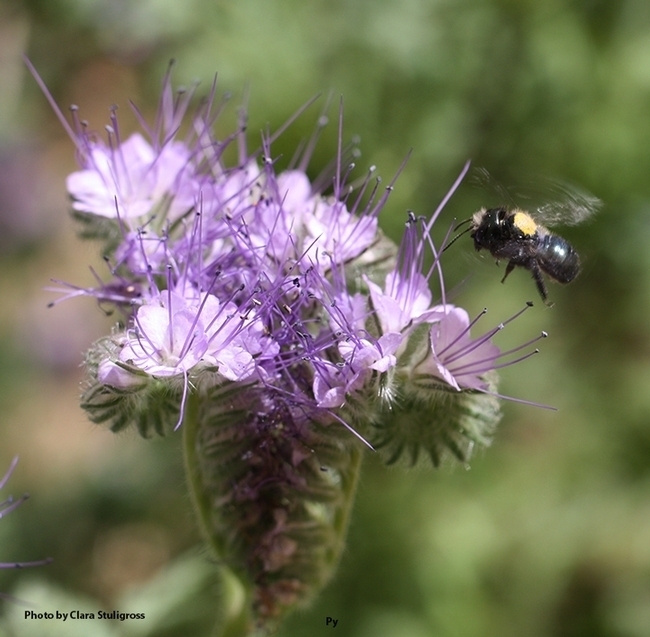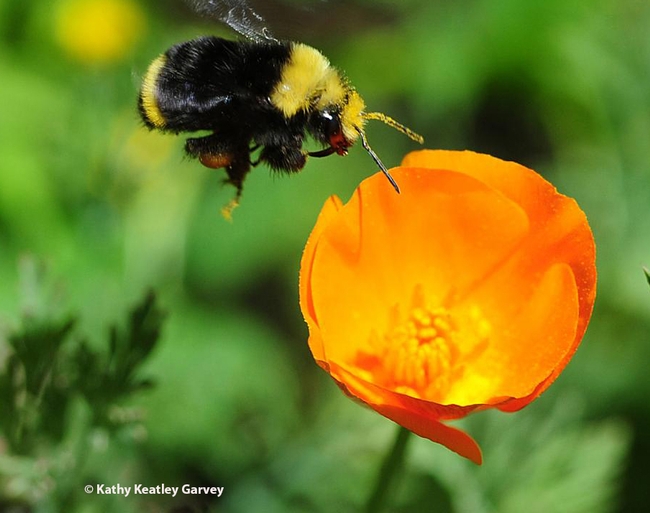
Stuligross, who received her doctorate in ecology on Sept. 9 from UC Davis, will present her exit seminar, "Individual and Combined Effects of Resource and Pesticide Stressors on Wild Bees and a Potential Strategy to Mitigate Impacts" at 10 a.m., Tuesday, Oct. 18 in Room 1022 of Green Hall.
The seminar, open to all interested persons, also will be virtual. The Zoom link is https://ucdavis.zoom.us/j/3661107142.
Stuligross researches nutrition and pesticide exposure and their comparative effects on the blue orchard bee, Osmia lignaria, and the yellow-faced bumble bee, Bombus vosnesenskii. Pollination ecologist Neal Williams, professor in the Department of Entomology and Nematology, served as her major professor.
"I am doing a short postdoc with Neal Williams this fall, and in January I will start a postdoctoral research position with Nicole Rafferty at UC Riverside," Stuligross said.
"Anthropogenic environmental changes present multiple stressors that together impact biodiversity and ecosystem function," Stuligross writes in her abstract. "Among these, pesticide exposure and the loss of flowering plants are ubiquitous across contemporary landscapes and threaten the persistence of bee populations. In this dissertation, I explored the individual and combined effects of pesticide and floral resource stressors on bee behavior, reproduction, and population persistence, as well as a potential strategy for mitigating these impacts. I used a combination of manipulative field cage experiments and landscape studies to examine these stressors and their impacts at different scales.
"Because bees often experience pesticide and resource stressors simultaneously, I first examined the potential for interactive effects of these stressors, as well as their individual impacts on wild bees. I established a fully crossed design in field cages; nesting female Osmia lignaria, the solitary blue orchard bee, accessed wildflowers at high or low densities, treated with or without the common insecticide, imidacloprid. In Chapter 1, I showed that pesticide exposure and floral resource scarcity combined additively to dramatically alter multiple vital rates, including reduced reproduction and a male-biased offspring sex ratio. In Chapter 2, I quantified behavioral responses in the same experiment, revealing that the resource and pesticide stressors had differential impacts with consequences for bee populations and potentially for pollination services through individual behavioral changes. Limited floral resources required bees to make fewer, longer foraging trips as well as misidentify their nests more often upon return from these trips. Bees exposed to pesticides made shorter foraging trips and did not compensate for this by taking more trips, reducing their overall foraging activity. Pesticide exposure also interacted with age to affect antagonistic behavior."
"In Chapter 3, I examined the carryover effects of past pesticide exposure on wild bees. Using the offspring from the previous cage experiment with known pesticide exposure backgrounds, I re-established the field cages and released bees in a crossed design with pesticide exposure or no exposure in each year. Thus, some bees experienced pesticides over two generations and others not at all. Regardless of the past exposure history, pesticides in the second year reduced reproduction. For bees that were also exposed in the past, the exposure over two years additively impaired individual performance, leading to a nearly fourfold estimated reduction in bee population growth. Furthermore, even past exposure by itself, regardless of exposure in the second year, led to a decline in offspring production."
"In Chapter 4, I collaborated with Maj Rundlöf to investigate the potential for wildflower plantings to mitigate the negative effects of pesticide exposure in agricultural landscapes. We assessed the nesting and reproduction of O. lignaria and the bumble bee Bombus vosnesenskii in replicate agricultural landscapes, half of which contained a wildflower planting next to the nest or colony. We collected pollen from foraging bees to determine resource use and pesticide residues. The wildflower plantings were a source of pesticide exposure, especially for O. lignaria, but also supported O. lignaria nesting. The landscape-level floral resources better predicted B. vosnesenskii colony success, but the local flower resources mitigated the negative effects of pesticides on their reproduction."
"These chapters together show that two common environmental stressors combine to negativel impact bees. They also reveal potential mechanisms underlying impacts of the stressors on reproduction and population growth. My dissertation highlights the importance of mitigating the negative effects of pesticides and floral resource limitation, especially in agricultural landscapes where the two stressors often co-occur. Finally, this work offers insight into how the stressors could be mitigated through an emerging strategy to diversity agricultural landscapes."
Stuligross received her bachelor of arts degree in environmental studies in 2014 in Indiana from Earlham College, Richmond, where she minored in biology and outdoor education. At UC Davis, she was awarded a 2017-22 National Science Foundation Graduate Research Fellowship, and a 2016-18 UC Davis Graduate Group in Ecology Fellowship.
Recognized nationally for her research, Stuligross scored second place in the Entomological Society of America's 2020 President's Prize competition. Her research posters also won the top award at the UC Davis Graduate Student Symposium in Ecology in both 2019 and 2021.
Stuligross and her colleague, Maj Rundlöf, are the co-first authors of "Flower Plantings Support Wild Bee Reproduction and May Also Mitigate Pesticide Exposure Effects," published in May 2022 in the Journal of Applied Ecology. She was the lead author of "Past Insecticide Exposure Reduces Bee Reproduction and Population Growth Rate," published in November 2021 in the Proceedings of the National Academy of Sciences, and also the lead author of "Pesticide and Resource Stressors Sdditively Impair Wild Bee Reproduction," published in September 2020 in The Proceedings of the Royal Society B.
Stuligross has also co-authored a number of other research publications, most recently:
- "A Meta-Analysis of Single Visit Pollination Effectiveness Comparing Honeybees and Other Floral Visitors," American Journal of Botany
- "Impact of 'Nonlethal' Tarsal Clipping on Bumble Bees (Bombus vosnesenskii) May Depend on Queen Stage and Worker Size," Journal of Insect Conservation
Want to learn more about wild bees, also known as undomesticated bees? Be sure to read the UC-authored book, California Bees and Blooms: A Guide for Gardeners and Naturalists. It's the work of Gordon Frankie of UC Berkeley, the late Robbin Thorp of the UC Davis Department of Entomology and Nematology; Barbara Ertter of UC Berkeley; and photographer Rollin Coville, alumnus of UC Berkeley. California is home to more than 1600 species of undomesticated or wild bees.
Attached Images:

